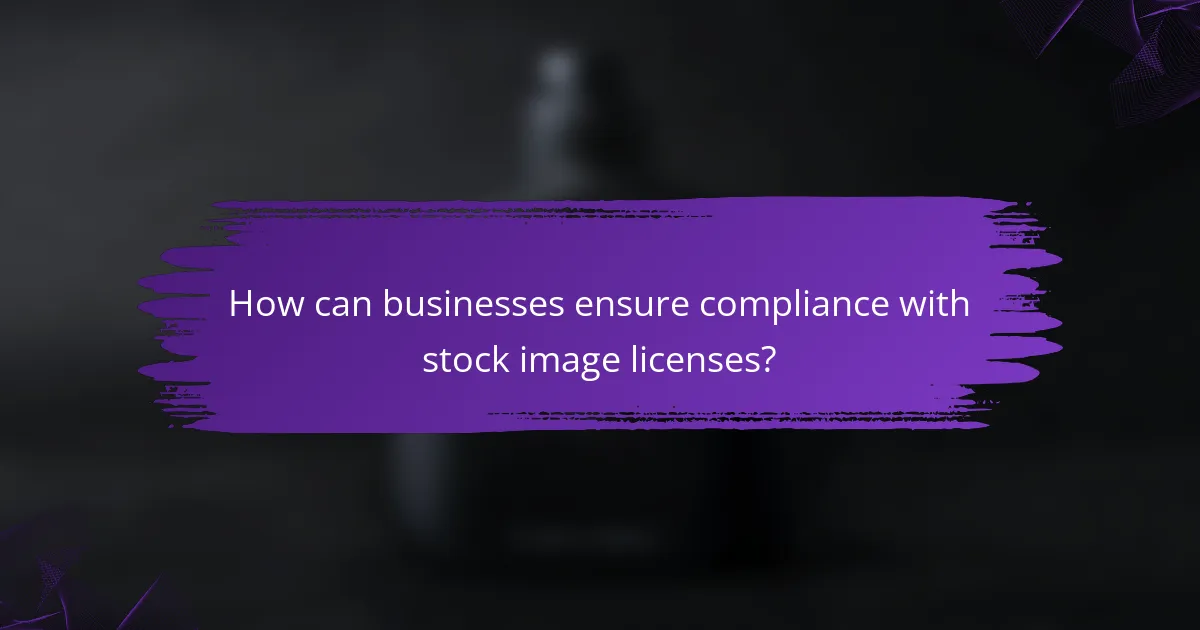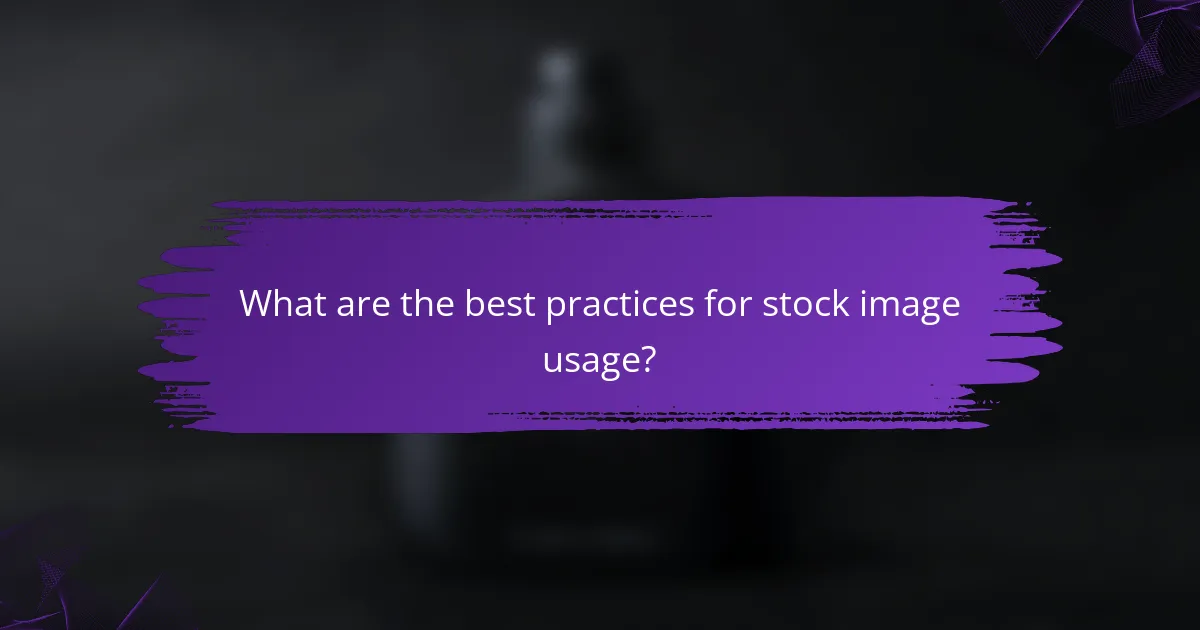Understanding stock image licensing compliance is crucial for businesses to legally use images and avoid potential legal issues. Key considerations include familiarizing oneself with various licensing types, usage rights, and the importance of adhering to specific terms of use. By implementing systematic processes and maintaining accurate records, businesses can effectively navigate licensing agreements and ensure compliance.

What are the key considerations for stock image licensing compliance in the US?
Key considerations for stock image licensing compliance in the US include understanding the various licensing types, recognizing the importance of usage rights, and being aware of the consequences of non-compliance. Adhering to these aspects ensures legal use of images and protects against potential legal issues.
Understanding licensing types
Stock images typically come with different licensing types, such as royalty-free and rights-managed. Royalty-free licenses allow users to pay a one-time fee for broad usage without ongoing royalties, while rights-managed licenses require specific permissions for each use, often with restrictions on duration and distribution.
It’s essential to read the licensing agreements carefully to understand what is permitted. For example, a royalty-free image may still have limitations on resale or use in merchandise, which can vary by provider.
Importance of usage rights
Usage rights define how and where stock images can be utilized. Complying with these rights is crucial to avoid legal repercussions. For instance, using an image for commercial purposes without the appropriate license can lead to copyright infringement claims.
Always verify the intended use against the granted rights. If an image is licensed for web use only, using it in print materials could violate the agreement. Keeping a record of licenses and their terms can help maintain compliance.
Consequences of non-compliance
Non-compliance with stock image licensing can result in significant legal consequences, including hefty fines and lawsuits. Violating licensing terms may lead to the removal of content and damage to your brand’s reputation.
To mitigate risks, it’s advisable to conduct regular audits of your image usage. Establishing a checklist for compliance can help ensure that all images are used according to their licensing agreements, protecting your organization from potential legal issues.

How can businesses ensure compliance with stock image licenses?
Businesses can ensure compliance with stock image licenses by understanding the specific terms of use for each image and implementing systematic processes to adhere to these guidelines. This includes maintaining accurate records and regularly reviewing licensing agreements to avoid potential legal issues.
Implementing a compliance checklist
A compliance checklist is a practical tool for businesses to ensure they follow stock image licensing requirements. This checklist should include key elements such as verifying the license type, noting usage restrictions, and tracking expiration dates of licenses.
Regularly updating the checklist can help identify any lapses in compliance. For example, a checklist might include items like confirming the source of the image, ensuring proper attribution, and checking for any geographical limitations on usage.
Training staff on licensing agreements
Training staff on licensing agreements is crucial for maintaining compliance. Employees should be educated about the different types of licenses, such as royalty-free and rights-managed, and the implications of each.
Consider conducting regular workshops or providing online resources to keep staff informed. This training can help prevent common pitfalls, such as using images beyond their licensed scope or failing to credit the creator when required.
Using compliance management tools
Compliance management tools can streamline the process of tracking stock image licenses and usage. These tools often provide features like automated reminders for license renewals and centralized storage for licensing documents.
Investing in such tools can save time and reduce the risk of non-compliance. Look for solutions that integrate with your existing workflow, allowing for easy access and management of image licenses across your organization.

What are the best practices for stock image usage?
Best practices for stock image usage include understanding licensing agreements, adhering to attribution requirements, and being aware of any limitations on modifications. Following these guidelines ensures compliance and protects against legal issues.
Attribution requirements
Attribution requirements dictate how you must credit the creator of a stock image. Many licenses, especially those under Creative Commons, require you to provide proper acknowledgment, which typically includes the creator’s name and a link to the source.
Failure to attribute correctly can lead to legal repercussions, including potential fines. Always check the specific licensing terms for each image to ensure compliance with attribution standards.
Limitations on modifications
Limitations on modifications refer to restrictions on altering stock images. Some licenses allow for edits, while others prohibit modifications entirely, meaning you must use the image as is.
When using images that require no modifications, ensure that your intended use aligns with the license. If modifications are allowed, keep in mind that significant changes may still require additional permissions from the creator.
Geographic restrictions
Geographic restrictions can limit where and how stock images can be used based on the licensing agreement. Some licenses may only permit usage in specific countries or regions, which can affect marketing and distribution strategies.
Before using an image, verify any geographic limitations to avoid potential violations. This is particularly important for businesses operating internationally, as compliance with local laws and regulations is essential.

What tools can assist with stock image licensing management?
Several tools can streamline stock image licensing management, helping users track usage rights and ensure compliance. These tools often provide features for monitoring licenses, managing downloads, and maintaining records of image usage.
Adobe Stock licensing features
Adobe Stock offers integrated licensing features within its Creative Cloud applications, allowing users to easily manage their stock image licenses. Users can access license information directly from the Adobe interface, which helps ensure compliance with usage terms.
Additionally, Adobe provides a centralized dashboard where users can view their licensed assets and track expiration dates. This feature is particularly useful for teams, as it helps maintain clarity on who has access to which images.
Getty Images compliance resources
Getty Images provides a variety of compliance resources, including detailed licensing agreements and guidelines for proper image usage. Users can access educational materials that explain the nuances of different license types, such as rights-managed and royalty-free options.
Moreover, Getty offers a license management tool that allows users to monitor their image usage and ensure they remain within the bounds of their purchased licenses. This tool can help prevent potential legal issues related to unauthorized use.
Shutterstock license tracking tools
Shutterstock features robust license tracking tools that help users keep tabs on their stock image usage. The platform allows users to view their download history and monitor the status of each license, ensuring compliance with licensing agreements.
Shutterstock also offers a user-friendly interface that simplifies the process of managing multiple licenses. Users can set reminders for license renewals and access reports that detail their usage patterns, which can be beneficial for budgeting and planning future purchases.

What are the emerging trends in stock image licensing?
Emerging trends in stock image licensing reflect shifts in how images are sourced, used, and compensated. Key developments include a move towards subscription models, a heightened emphasis on ethical sourcing, and the influence of AI-generated images on traditional licensing practices.
Shift towards subscription models
Subscription models are becoming increasingly popular in stock image licensing, allowing users to access a vast library of images for a fixed monthly fee. This approach offers flexibility and cost-effectiveness, particularly for businesses that require a steady stream of visual content.
Many platforms now offer tiered subscription plans, catering to different user needs, from small startups to large enterprises. Users should evaluate their image usage patterns to choose the most suitable plan, balancing cost against the number of downloads and image quality.
Increased focus on ethical sourcing
There is a growing demand for ethically sourced images, driven by consumer awareness and corporate responsibility. Stock image providers are increasingly prioritizing transparency in their sourcing practices, ensuring that contributors are fairly compensated and that images do not exploit subjects.
Brands are encouraged to select stock images from platforms that emphasize ethical standards, which can enhance their reputation and align with consumer values. This trend may also involve verifying the licensing agreements to ensure compliance with ethical sourcing guidelines.
Impact of AI-generated images on licensing
The rise of AI-generated images is reshaping stock image licensing by introducing new challenges and opportunities. AI tools can create unique visuals quickly, which may reduce reliance on traditional stock images but also complicate copyright and licensing issues.
As AI-generated content becomes more prevalent, licensing agreements will need to adapt to address ownership rights and usage limitations. Users should stay informed about the evolving regulations surrounding AI-generated images to ensure compliance and protect their interests.
